迷宫问题求解
数据结构课程设计迷宫问题求解
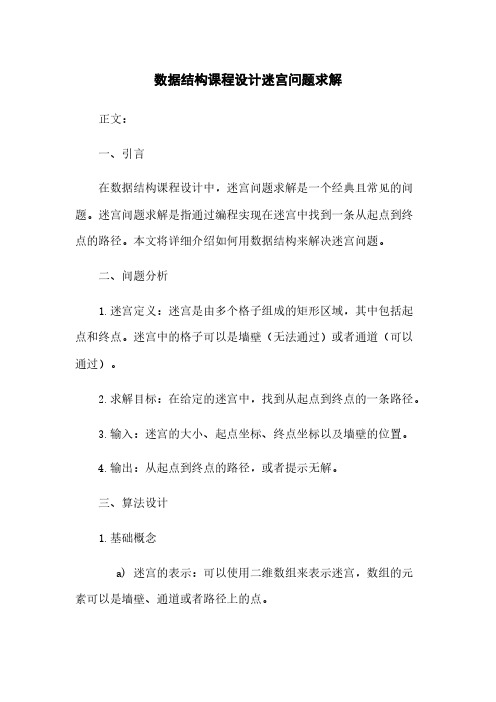
数据结构课程设计迷宫问题求解正文:一、引言在数据结构课程设计中,迷宫问题求解是一个经典且常见的问题。
迷宫问题求解是指通过编程实现在迷宫中找到一条从起点到终点的路径。
本文将详细介绍如何用数据结构来解决迷宫问题。
二、问题分析1.迷宫定义:迷宫是由多个格子组成的矩形区域,其中包括起点和终点。
迷宫中的格子可以是墙壁(无法通过)或者通道(可以通过)。
2.求解目标:在给定的迷宫中,找到从起点到终点的一条路径。
3.输入:迷宫的大小、起点坐标、终点坐标以及墙壁的位置。
4.输出:从起点到终点的路径,或者提示无解。
三、算法设计1.基础概念a) 迷宫的表示:可以使用二维数组来表示迷宫,数组的元素可以是墙壁、通道或者路径上的点。
b) 坐标系统:可以使用(x, y)来表示迷宫中各个点的坐标。
c) 方向定义:可以用上、下、左、右等四个方向来表示移动的方向。
2.深度优先搜索算法(DFS)a) 算法思想:从起点开始,沿着一个方向一直走到无法继续为止,然后回退到上一个点,再选择其他方向继续探索。
b) 算法步骤:i) 标记当前点为已访问。
ii) 判断当前点是否为终点,如果是则返回路径;否则继续。
iii) 遍历四个方向:1.如果该方向的下一个点是通道且未访问,则继续向该方向前进。
2.如果该方向的下一个点是墙壁或已访问,则尝试下一个方向。
iv) 如果四个方向都无法前进,则回退到上一个点,继续向其他方向探索。
3.广度优先搜索算法(BFS)a) 算法思想:从起点开始,逐层向外探索,直到找到终点或者所有点都被访问。
b) 算法步骤:i) 标记起点为已访问,加入队列。
ii) 循环以下步骤直到队列为空:1.取出队首元素。
2.判断当前点是否为终点,如果是则返回路径;否则继续。
3.遍历四个方向:a.如果该方向的下一个点是通道且未访问,则标记为已访问,加入队列。
iii) 如果队列为空仍未找到终点,则提示无解。
四、算法实现1.选择合适的编程语言和开发环境。
迷宫问题算法
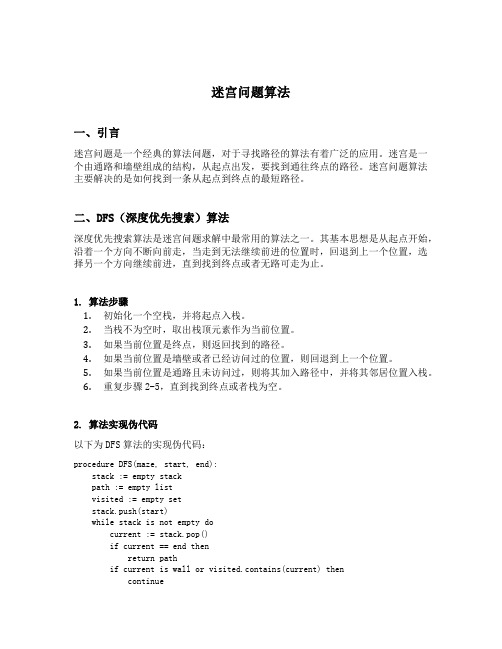
迷宫问题算法一、引言迷宫问题是一个经典的算法问题,对于寻找路径的算法有着广泛的应用。
迷宫是一个由通路和墙壁组成的结构,从起点出发,要找到通往终点的路径。
迷宫问题算法主要解决的是如何找到一条从起点到终点的最短路径。
二、DFS(深度优先搜索)算法深度优先搜索算法是迷宫问题求解中最常用的算法之一。
其基本思想是从起点开始,沿着一个方向不断向前走,当走到无法继续前进的位置时,回退到上一个位置,选择另一个方向继续前进,直到找到终点或者无路可走为止。
1. 算法步骤1.初始化一个空栈,并将起点入栈。
2.当栈不为空时,取出栈顶元素作为当前位置。
3.如果当前位置是终点,则返回找到的路径。
4.如果当前位置是墙壁或者已经访问过的位置,则回退到上一个位置。
5.如果当前位置是通路且未访问过,则将其加入路径中,并将其邻居位置入栈。
6.重复步骤2-5,直到找到终点或者栈为空。
2. 算法实现伪代码以下为DFS算法的实现伪代码:procedure DFS(maze, start, end):stack := empty stackpath := empty listvisited := empty setstack.push(start)while stack is not empty docurrent := stack.pop()if current == end thenreturn pathif current is wall or visited.contains(current) thencontinuepath.append(current)visited.add(current)for each neighbor in getNeighbors(current) dostack.push(neighbor)return "No path found"三、BFS(广度优先搜索)算法广度优先搜索算法也是解决迷宫问题的常用算法之一。
迷宫问题求解算法设计实验报告

迷宫问题求解算法设计实验报告一、引言迷宫问题一直是计算机科学中的一个经典问题,其解决方法也一直是研究者们探讨的重点之一。
本实验旨在通过设计不同的算法,对迷宫问题进行求解,并对比不同算法的效率和优缺点。
二、算法设计1. 暴力搜索算法暴力搜索算法是最简单直接的求解迷宫问题的方法。
其基本思路是从起点开始,按照某种规则依次尝试所有可能的路径,直到找到终点或所有路径都被尝试过为止。
2. 广度优先搜索算法广度优先搜索算法也称为BFS(Breadth First Search),其基本思路是从起点开始,按照层次依次遍历每个节点,并将其相邻节点加入队列中。
当找到终点时,即可得到最短路径。
3. 深度优先搜索算法深度优先搜索算法也称为DFS(Depth First Search),其基本思路是从起点开始,沿着某一个方向走到底,再回溯到上一个节点继续向其他方向探索。
当找到终点时,即可得到一条路径。
4. A* 算法A* 算法是一种启发式搜索算法,其基本思路是综合考虑节点到起点的距离和节点到终点的距离,选择最优的路径。
具体实现中,可以使用估价函数来计算每个节点到终点的距离,并将其加入优先队列中。
三、实验过程本实验使用 Python 语言编写程序,在不同算法下对迷宫问题进行求解。
1. 数据准备首先需要准备迷宫数据,可以手动输入或从文件中读取。
本实验使用二维数组表示迷宫,其中 0 表示墙壁,1 表示路径。
起点和终点分别用 S 和 E 表示。
2. 暴力搜索算法暴力搜索算法比较简单直接,只需要按照某种规则遍历所有可能的路径即可。
具体实现中,可以使用递归函数来实现深度遍历。
3. 广度优先搜索算法广度优先搜索算法需要使用队列来存储待遍历的节点。
具体实现中,每次从队列中取出一个节点,并将其相邻节点加入队列中。
4. 深度优先搜索算法深度优先搜索算法也需要使用递归函数来实现深度遍历。
具体实现中,在回溯时需要将已经访问过的节点标记为已访问,防止重复访问。
数据结构迷宫问题求解

学号专业计算机科学与技术姓名实验日期2017.6.20教师签字成绩实验报告【实验名称】迷宫问题的求解【实验目的】(1)通过本课程的学习,能熟练掌握几种基本数据结构的基本操作。
(2)能针对给定题目,选择相应的数据结构,分析并设计算法,进而给出问题的正确求解过程并编写代码实现。
(3)用递归和非递归两种方式完成迷宫问题的求解。
【实验原理】迷宫问题通常是用“穷举求解”方法解决,即从入口出发,顺着某一个方向进行探索,若能走通,则继续往前走;否则沿着原路退回,换一个方向继续探索,直至出口位置,求得一条通路。
假如所有可能的通路都探索到而未能到达出口,则所设定的迷宫没有通路。
栈是一个后进先出的结构,可以用来保存从入口到当前位置的路径。
【实验内容】1 需求分析1.基本要求:(1)首先实现一个以链表作存储结构的栈类型,然后编写一个求解迷宫的非递归程序。
求得的通路以三元组(i,j,d)的形式输出。
其中:(i,j)指示迷宫中的一个坐标,d表示走到下一坐标的方向。
如,对于教材第50页图3.4所示的迷宫,输出一条通路为:(1,1,1),(1,2,2),(2,2,2),(3,2,3),(3,1,2),…(2)编写递归形式的算法,求得迷宫中所有可能的通路。
(3)以方阵形式输出迷宫和其通路。
(4)按照题意要求独立进行设计,设计结束后按要求写出设计报告。
2.输入输出的要求:(i) 求得的通路以三元组(i,j,d)的形式输出,其中:(i,j)指示迷宫中的一个坐标,d表示走到下一个坐标的方向。
(ii)输出迷宫示意图3.程序所能达到的功能:(i) 实现一个以链表作存储结构的栈类型,以非递归算法求出通路(ii)以一个递归算法,对任意输入的迷宫矩阵求出所有通路。
2 概要设计1.①构建一个二维数组maze[M][N]用于存储迷宫矩阵②手动生成迷宫,即为二维数组maze[M][N]赋值③构建一个栈用于存储迷宫路径④建立迷宫节点用于存储迷宫中每个节点的访问情况;非递归本程序包含6个函数:(1)主函数 main()(2)生成迷宫 create_maze()(4)打印迷宫 print_maze()(5)搜索迷宫路径并用三元组输出路径 mgpath()(6)用图来输出路径print_tu();递归本程序包含3个函数:(1)主函数main();(2)打印迷宫printmaze();(3)搜索迷宫路径pass(int x,int y);3. 详细设计1.非递归起点和终点的结构类型 typedef struct{int h;int l;}T;栈节点类型 typedef struct cell{int row;int col;int dir;}TCell;1.生成迷宫void creat_maze(int a,int b){定义i,j为循环变量for(i<a)for(j<b)输入maze[i][j]的值}2.打印迷宫void print_maze(int m,int n){用i,j循环变量,将maze[i][j]输出}3.搜索迷宫路径void mazepath(int maze[][],T s,T e) //参数传递迷宫和起点与终点{TCell S[N1*N2];top=0; //建立栈S[top].row=s.h;S[top].col=s.l;S[top].dir=-1; //起点入栈while(top>=0) //判栈是否空{ i,j为当前访问点的位置if(i,j是终点坐标)用循环输出栈里的元素;else 将(i,j),即访问点入栈,然后向四周寻找是否有通路,若有通路,将原访问点标记(赋值-1),选一条通路作为新访问点,入栈。
数据结构迷宫求解

数据结构迷宫求解迷宫问题是一种常见的求解问题,通过在迷宫中找到从起点到终点的路径。
在计算机科学中,使用数据结构来解决迷宫问题非常方便。
本文将介绍迷宫问题的基本原理、常见的求解方法以及使用不同数据结构的优缺点。
首先,我们需要明确迷宫的基本定义。
迷宫可以看作是一个二维的网格,其中包含一些墙壁和通路。
起点是迷宫的入口,终点则是迷宫的出口。
我们的目标是找到从起点到终点的一条路径。
迷宫问题可以使用多种算法求解,包括深度优先(DFS)、广度优先(BFS)、最短路径算法等。
以下将详细介绍这些算法以及它们在迷宫问题中的应用。
同时,我们还会讨论不同数据结构在求解迷宫问题中的优缺点。
首先,深度优先(DFS)是一种常用的求解迷宫问题的算法。
该算法从起点开始,一直到终点,期间遇到墙壁或已经访问过的点则回溯到上一个节点。
DFS可以使用递归实现,也可以使用栈来保存需要回溯的节点。
DFS的优点是简单易懂,易于实现。
然而,它可能会陷入死循环或者找到一条较长的路径而不是最短路径。
另一种常见的算法是广度优先(BFS),它从起点开始,逐层扩展,直到找到终点为止。
BFS可以使用队列来保存每一层的节点。
与DFS相比,BFS能够找到最短路径,但它需要维护一个较大的队列,从而增加了空间复杂度。
除了DFS和BFS,还有一些其他算法可以应用于迷宫问题。
例如,迪杰斯特拉算法和A*算法可以找到最短路径。
这些算法使用了图的概念,将迷宫中的通道表示为图的边,将各个节点之间的距离表示为图的权重。
然后,通过计算最短路径的权重,找到从起点到终点的最短路径。
迪杰斯特拉算法和A*算法的优点是能够找到最短路径,但它们的实现较为复杂。
在使用这些算法求解迷宫问题时,我们需要选择适合的数据结构来存储迷宫和过程中的状态。
以下是几种常见的数据结构以及它们的优缺点:1.数组:数组是一种常见的数据结构,它可以用来表示迷宫。
可以使用二维数组来表示迷宫的网格,并使用特定的值表示墙壁和通路。
迷宫问题算法
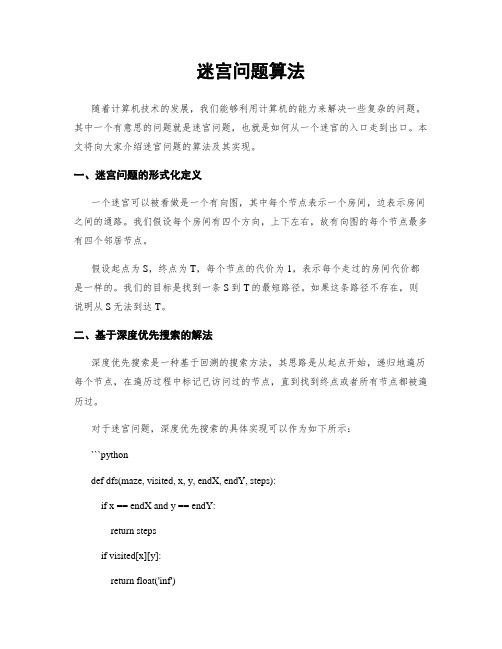
迷宫问题算法随着计算机技术的发展,我们能够利用计算机的能力来解决一些复杂的问题。
其中一个有意思的问题就是迷宫问题,也就是如何从一个迷宫的入口走到出口。
本文将向大家介绍迷宫问题的算法及其实现。
一、迷宫问题的形式化定义一个迷宫可以被看做是一个有向图,其中每个节点表示一个房间,边表示房间之间的通路。
我们假设每个房间有四个方向,上下左右,故有向图的每个节点最多有四个邻居节点。
假设起点为S,终点为T,每个节点的代价为1,表示每个走过的房间代价都是一样的。
我们的目标是找到一条S到T的最短路径。
如果这条路径不存在,则说明从S无法到达T。
二、基于深度优先搜索的解法深度优先搜索是一种基于回溯的搜索方法,其思路是从起点开始,递归地遍历每个节点,在遍历过程中标记已访问过的节点,直到找到终点或者所有节点都被遍历过。
对于迷宫问题,深度优先搜索的具体实现可以作为如下所示:```pythondef dfs(maze, visited, x, y, endX, endY, steps):if x == endX and y == endY:return stepsif visited[x][y]:return float('inf')visited[x][y] = TrueminSteps = float('inf')for dx, dy in ((0, 1), (1, 0), (0, -1), (-1, 0)):nx, ny = x + dx, y + dyif 0 <= nx < len(maze) and 0 <= ny < len(maze[0]) and maze[nx][ny] == 0:newSteps = dfs(maze, visited, nx, ny, endX, endY, steps + 1)minSteps = min(minSteps, newSteps)visited[x][y] = Falsereturn minSteps```在这个实现中,我们使用了一个visited数组来记录每个节点是否被访问过,1表示被访问过,0表示未被访问过。
迷宫问题求解PPT课件

机遇
随着人工智能和机器学习技术的不断发展,越来越多的算法和模型被应用于迷宫问题求解,如深度学习、强化学 习等。这些算法和模型在处理大规模、复杂迷宫问题方面展现出了强大的潜力和优势,为迷宫问题求解带来了新 的机遇和突破。
并行化搜索适用于具 有良好并行性的迷宫 问题,可以显著提高 求解效率。
通过使用并行计算资 源,可以同时搜索多 个路径,加快求解速 度。
04
迷宫求解的实践案例
简单的迷宫求解
使用深度优先搜索(DFS)
01
从起点开始,探索所有可能的路径,直到找到终点或无路可走。
使用广度优先搜索(BFS)
02
按照从起点到终点的路径长度,逐层搜索,直到找到终点或无
未来研究方向
算法优化
智能化求解
应用拓展
理论分析
针对迷宫问题求解,进一步优 化现有算法和模型,提高求解 效率和质量。研究新的算法和 模型,以更好地处理大规模、 复杂迷宫问题。
结合人工智能和机器学习技术 ,研究智能化求解方法,如基 于深度学习的路径规划、强化 学习算法等。通过智能化技术 提高迷宫问题求解的自动化和 智能化水平。
路可走。
使用回溯法
03
从起点开始,尝试所有可能的路径,如果遇到死胡同或无法到
达终点,则回溯到上一个节点,继续尝试其他路径。优先搜索,在迷宫中寻找 最短路径。
使用遗传算法
模拟生物进化过程,通过交叉、变异等操作,寻 找最优解。
使用模拟退火算法
模拟物理退火过程,通过随机扰动和接受概率, 寻找最优解。
课程设计求解迷宫问题

课程设计求解迷宫问题一、教学目标本课程旨在通过求解迷宫问题,使学生掌握迷宫问题的基本概念、求解方法和算法。
具体目标如下:1.了解迷宫问题的定义、分类和应用场景。
2.掌握迷宫问题的基本求解方法,如深度优先搜索、广度优先搜索、启发式搜索等。
3.理解迷宫问题的算法复杂度和优化方法。
4.能够运用深度优先搜索、广度优先搜索、启发式搜索等方法解决实际迷宫问题。
5.能够分析迷宫问题的特点,选择合适的算法进行求解。
6.能够编写程序实现迷宫问题的求解算法。
情感态度价值观目标:1.培养学生的逻辑思维能力和问题解决能力。
2.激发学生对计算机科学和的兴趣。
3.培养学生的团队合作意识和交流表达能力。
二、教学内容本课程的教学内容主要包括迷宫问题的基本概念、求解方法和算法。
具体安排如下:1.迷宫问题的定义、分类和应用场景。
2.深度优先搜索算法及其实现。
3.广度优先搜索算法及其实现。
4.启发式搜索算法及其实现。
5.迷宫问题的算法复杂度和优化方法。
三、教学方法为了激发学生的学习兴趣和主动性,本课程将采用多种教学方法相结合的方式。
具体方法如下:1.讲授法:通过讲解迷宫问题的基本概念、求解方法和算法,使学生掌握相关知识。
2.案例分析法:通过分析实际案例,使学生更好地理解迷宫问题的求解方法和算法。
3.实验法:让学生动手编写程序,实现迷宫问题的求解算法,提高学生的实际操作能力。
4.讨论法:学生进行分组讨论,培养学生的团队合作意识和交流表达能力。
四、教学资源为了支持教学内容和教学方法的实施,丰富学生的学习体验,我们将准备以下教学资源:1.教材:《计算机科学导论》相关章节。
2.参考书:《算法导论》等相关书籍。
3.多媒体资料:相关教学PPT、视频资料等。
4.实验设备:计算机、编程环境等。
通过以上教学资源的使用,我们将帮助学生更好地掌握迷宫问题的求解方法和算法,提高他们的计算机科学素养。
五、教学评估为了全面、客观、公正地评估学生在课程中的学习成果,我们将采用多种评估方式相结合的方法。
迷宫问题的求解(回溯法、深度优先遍历、广度优先遍历)
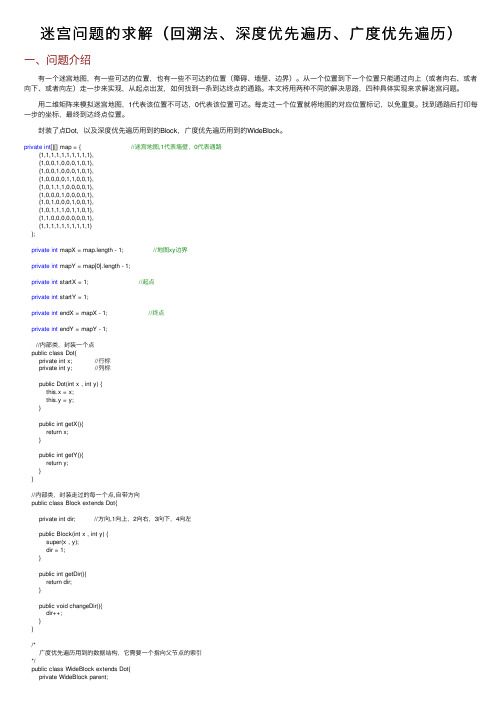
迷宫问题的求解(回溯法、深度优先遍历、⼴度优先遍历)⼀、问题介绍 有⼀个迷宫地图,有⼀些可达的位置,也有⼀些不可达的位置(障碍、墙壁、边界)。
从⼀个位置到下⼀个位置只能通过向上(或者向右、或者向下、或者向左)⾛⼀步来实现,从起点出发,如何找到⼀条到达终点的通路。
本⽂将⽤两种不同的解决思路,四种具体实现来求解迷宫问题。
⽤⼆维矩阵来模拟迷宫地图,1代表该位置不可达,0代表该位置可达。
每⾛过⼀个位置就将地图的对应位置标记,以免重复。
找到通路后打印每⼀步的坐标,最终到达终点位置。
封装了点Dot,以及深度优先遍历⽤到的Block,⼴度优先遍历⽤到的WideBlock。
private int[][] map = { //迷宫地图,1代表墙壁,0代表通路{1,1,1,1,1,1,1,1,1,1},{1,0,0,1,0,0,0,1,0,1},{1,0,0,1,0,0,0,1,0,1},{1,0,0,0,0,1,1,0,0,1},{1,0,1,1,1,0,0,0,0,1},{1,0,0,0,1,0,0,0,0,1},{1,0,1,0,0,0,1,0,0,1},{1,0,1,1,1,0,1,1,0,1},{1,1,0,0,0,0,0,0,0,1},{1,1,1,1,1,1,1,1,1,1}};private int mapX = map.length - 1; //地图xy边界private int mapY = map[0].length - 1;private int startX = 1; //起点private int startY = 1;private int endX = mapX - 1; //终点private int endY = mapY - 1; //内部类,封装⼀个点public class Dot{private int x; //⾏标private int y; //列标public Dot(int x , int y) {this.x = x;this.y = y;}public int getX(){return x;}public int getY(){return y;}}//内部类,封装⾛过的每⼀个点,⾃带⽅向public class Block extends Dot{private int dir; //⽅向,1向上,2向右,3向下,4向左public Block(int x , int y) {super(x , y);dir = 1;}public int getDir(){return dir;}public void changeDir(){dir++;}}/*⼴度优先遍历⽤到的数据结构,它需要⼀个指向⽗节点的索引*/public class WideBlock extends Dot{private WideBlock parent;public WideBlock(int x , int y , WideBlock p){super(x , y);parent = p;}public WideBlock getParent(){return parent;}}⼆、回溯法 思路:从每⼀个位置出发,下⼀步都有四种选择(上右下左),先选择⼀个⽅向,如果该⽅向能够⾛下去,那么就往这个⽅向⾛,当前位置切换为下⼀个位置。
迷宫问题的求解与优化

[课程设计题二]
迷宫问题的求解与优化
[问题描述]
以回溯方法(试探法)和图的广度优先搜索法(路径最短的最优解)求解迷宫的路径,并以图形界面动画的步进方式显示,如下图为回溯方法得到的一个解。
老鼠有四个试探方向。
搜索的回溯算法可以使用栈结构(也可以应用递归)来求解,求最优解就是按图的广度优先搜索求最短路径,两者分开进行。
算法的每一步搜索动作应与界面的变化相协调。
[基本要求]
迷宫的状态可以有几种构造方法,固定的、随机的和人工手动的;也可以用人工方式对固定或随机的方案进行局部的修改。
搜索的动作快慢应能加以调节。
[测试数据]
可先以大小为20*20的迷宫(四周是围墙)进行测试,固定形态的迷宫应包括最终走通和走不通的各种情况;然后测试随机形态的迷宫,再测试人工布局的迷宫。
最后测试大尺寸的迷宫。
[实现提示]
回溯搜索算法可参阅《数据结构》P50,最短路径的算法可参阅《数据结构及应用算法教程》P162。
界面的动作和搜索的单步操作可分别调试完成,最后再通过彼此发消息的方式合成。
迷宫的每一个小单元、老鼠、入点、出点和记载走通的黄色单元格可考虑使用小位图来实现。
最终的图形界面建议如下,如迷宫较大可考虑使用滚动条。
[问题讨论]
迷宫分四方向问题和八方向问题之分,可在解决四方向问题后,再解八方向问题。
迷宫的求解
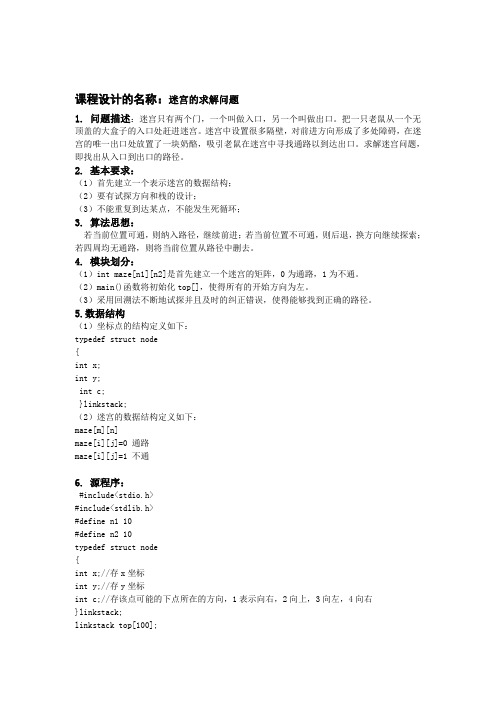
课程设计的名称:迷宫的求解问题1. 问题描述:迷宫只有两个门,一个叫做入口,另一个叫做出口。
把一只老鼠从一个无顶盖的大盒子的入口处赶进迷宫。
迷宫中设置很多隔壁,对前进方向形成了多处障碍,在迷宫的唯一出口处放置了一块奶酪,吸引老鼠在迷宫中寻找通路以到达出口。
求解迷宫问题,即找出从入口到出口的路径。
2. 基本要求:(1)首先建立一个表示迷宫的数据结构;(2)要有试探方向和栈的设计;(3)不能重复到达某点,不能发生死循环;3. 算法思想:若当前位置可通,则纳入路径,继续前进;若当前位置不可通,则后退,换方向继续探索;若四周均无通路,则将当前位置从路径中删去。
4. 模块划分:(1)int maze[n1][n2]是首先建立一个迷宫的矩阵,0为通路,1为不通。
(2)main()函数将初始化top[],使得所有的开始方向为左。
(3)采用回溯法不断地试探并且及时的纠正错误,使得能够找到正确的路径。
5.数据结构(1)坐标点的结构定义如下:typedef struct node{int x;int y;int c;}linkstack;(2)迷宫的数据结构定义如下:maze[m][n]maze[i][j]=0 通路maze[i][j]=1 不通6. 源程序:#include<stdio.h>#include<stdlib.h>#define n1 10#define n2 10typedef struct node{int x;//存x坐标int y;//存y坐标int c;//存该点可能的下点所在的方向,1表示向右,2向上,3向左,4向右}linkstack;linkstack top[100];//迷宫矩阵int maze[n1][n2]={1,1,1,1,1,1,1,1,1,1,0,0,0,1,0,0,0,1,0,1,1,1,0,1,0,0,0,1,0,1,1,0,0,0,0,1,1,0,0,1,1,0,1,1,1,0,0,0,0,1,1,0,0,0,1,0,0,0,0,0,1,0,1,0,0,0,1,0,0,1,1,0,1,1,1,0,1,1,0,1,1,1,0,0,0,0,0,0,0,1,1,1,1,1,1,1,1,1,1,1,};int i,j,k,m=0;main(){//初始化top[],置所有方向数向左for(i=0;i<n1*n2;i++){top[i].c=1;}printf("the maze is:\n");//打印原始迷宫矩阵for(i=0;i<n1;i++){for(j=0;j<n2;j++)printf(maze[i][j]?"*":"");printf("\n");}i=0;top[i].x=1;top[i].y=0;maze[1][0]=2;//回溯算法do{if(top[i].c<5)//还可以向前试探{if(top[i].x==5&&top[i].y==9)//已经找到一个组合{//打印路径printf("The way %d is:\n",m++);for(j=0;j<=i;j++){printf("(%d,%d)-->",top[j].x,top[j].y);}printf("\n");//打印选出路径的迷宫for(j=0;j<n1;j++){for(k=0;k<n2;k++){if(maze[j][k]==0)printf("");else if(maze[j][k]==2)printf("0");else printf("*");}printf("\n"); }maze[top[i].x][top[i].y]=0;top[i].c=1;i--;top[i].c+=1;continue; }switch(top[i].c)//向前试探{case 1:{if(maze[top[i].x][top[i].y+1]==0){i++;top[i].x=top[i-1].x;top[i].y=top[i-1].y+1;maze[top[i].x][top[i].y]=2;}else{top[i].c+=1;}break; }case 2:{if(maze[top[i].x-1][top[i].y]==0){i++;top[i].x=top[i-1].x-1;top[i].y=top[i-1].y;maze[top[i].x][top[i].y]=2;}else{top[i].c+=1;}break;}case 3:{if(maze[top[i].x][top[i].y-1]==0){i++;top[i].x=top[i-1].x;top[i].y=top[i-1].y-1;maze[top[i].x][top[i].y]=2;}else{top[i].c+=1;}break;}case 4:{if( maze[top[i].x+1][top[i].y]==0){i++;top[i].x=top[i-1].x+1;top[i].y=top[i-1].y;maze[top[i].x][top[i].y]=2;}else{top[i].c+=1;}break;}}}else//回溯{if(i==0)return 0;//已经找完所有解maze[top[i].x][top[i].y]=0;top[i].c=1;i--;top[i].c+=1;}}while(1);}7. 测试情况:截图:结果分析:通过程序运行的结果可以看出,此程序能够实现在有一个入口一个出口的情况下选择路径的功能,并且就此程序而言,有多条路径可以选择。
数据结构课程设计_迷宫求解
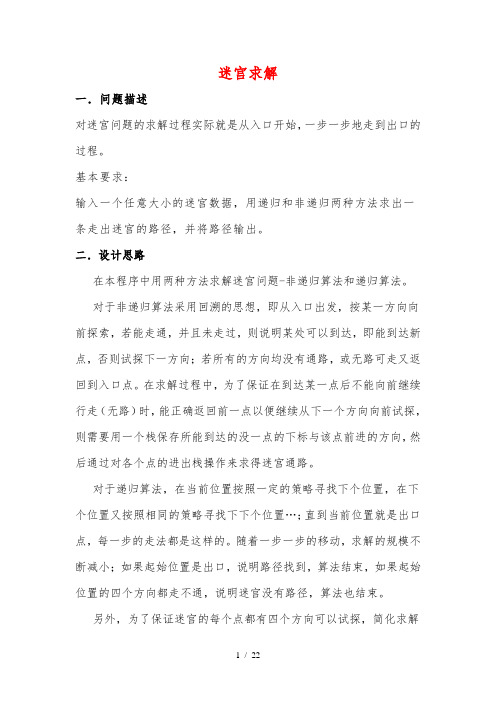
迷宫求解一.问题描述对迷宫问题的求解过程实际就是从入口开始,一步一步地走到出口的过程。
基本要求:输入一个任意大小的迷宫数据,用递归和非递归两种方法求出一条走出迷宫的路径,并将路径输出。
二.设计思路在本程序中用两种方法求解迷宫问题-非递归算法和递归算法。
对于非递归算法采用回溯的思想,即从入口出发,按某一方向向前探索,若能走通,并且未走过,则说明某处可以到达,即能到达新点,否则试探下一方向;若所有的方向均没有通路,或无路可走又返回到入口点。
在求解过程中,为了保证在到达某一点后不能向前继续行走(无路)时,能正确返回前一点以便继续从下一个方向向前试探,则需要用一个栈保存所能到达的没一点的下标与该点前进的方向,然后通过对各个点的进出栈操作来求得迷宫通路。
对于递归算法,在当前位置按照一定的策略寻找下个位置,在下个位置又按照相同的策略寻找下下个位置…;直到当前位置就是出口点,每一步的走法都是这样的。
随着一步一步的移动,求解的规模不断减小;如果起始位置是出口,说明路径找到,算法结束,如果起始位置的四个方向都走不通,说明迷宫没有路径,算法也结束。
另外,为了保证迷宫的每个点都有四个方向可以试探,简化求解过程,将迷宫四周的值全部设为1,因此将m行n列的迷宫扩建为m+2行,n+2列,同时用数组来保存迷宫阵列。
三.数据结构设计在迷宫阵列中每个点都有四个方向可以试探,假设当前点的坐标(x,y),与其相邻的四个点的坐标都可根据该点的相邻方位而得到,为了简化问题,方便求出新点的坐标,将从正东开始沿顺时针进行的这四个方向的坐标增量放在一个结构数组move[4]中,每个元素有两个域组成,其中x为横坐标增量,y为纵坐标增量,定义如下:typedef struct{int x,y;}item;为到达了某点而无路可走时需返回前一点,再从前一点开始向下一个方向继续试探。
因此,还要将从前一点到本点的方向压入栈中。
栈中的元素由行、列、方向组成,定义如下:typedef struct{int x,y,d;}DataType;由于在非递归算法求解迷宫的过程中用到栈,所以需定义栈的类型,本程序中用的是顺序栈,类型定义如下;typedef struct{DataType data[MAXSIZE];int top;}SeqStack, *PSeqStack;四.功能函数设计(1)函数PSeqStack Init_SeqStack()此函数实现对栈的初始化工作。
迷宫问题
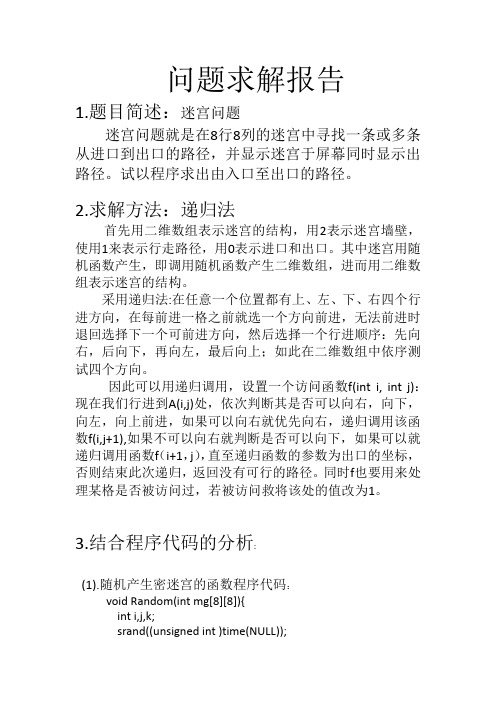
问题求解报告1.题目简述:迷宫问题迷宫问题就是在8行8列的迷宫中寻找一条或多条从进口到出口的路径,并显示迷宫于屏幕同时显示出路径。
试以程序求出由入口至出口的路径。
2.求解方法:递归法首先用二维数组表示迷宫的结构,用2表示迷宫墙壁,使用1来表示行走路径,用0表示进口和出口。
其中迷宫用随机函数产生,即调用随机函数产生二维数组,进而用二维数组表示迷宫的结构。
采用递归法:在任意一个位置都有上、左、下、右四个行进方向,在每前进一格之前就选一个方向前进,无法前进时退回选择下一个可前进方向,然后选择一个行进顺序:先向右,后向下,再向左,最后向上;如此在二维数组中依序测试四个方向。
因此可以用递归调用,设置一个访问函数f(int i, int j):现在我们行进到A(i,j)处,依次判断其是否可以向右,向下,向左,向上前进,如果可以向右就优先向右,递归调用该函数f(i,j+1),如果不可以向右就判断是否可以向下,如果可以就递归调用函数f(i+1,j),直至递归函数的参数为出口的坐标,否则结束此次递归,返回没有可行的路径。
同时f也要用来处理某格是否被访问过,若被访问救将该处的值改为1。
3.结合程序代码的分析:(1).随机产生密迷宫的函数程序代码:void Random(int mg[8][8]){int i,j,k;srand((unsigned int )time(NULL));for(i=1;i<7;i++)for(j=1;j<7;j++){k=rand()%3; //随机生成0、1、2三个数if(k)mg[i][j]=0;elseelsemg[i][j]=2;}}for(j=0;j<8;j++)mg[0][j]=mg[7][j]=2; /*设置迷宫外围"不可走",保证只有一个出口和入口*/for(i=0;i<8;i++)mg[i][0]=mg[i][7]=2; /*设置迷宫外围"不可走",保证只有一个出口和入口*/mg[1][0]=mg[6][7]=mg[1][1]=mg[6][6]=0; //将入口、出口设置为"0"即可通过;因为距入口或出口一步的路是必经之路,置于0;}(2).递归调用程序代码:void visit(int i, int j) { //访问各个格子,按优先顺序:先右,后下,再左,最后向上int m, n;maze[i][j] = 1;if(i == endI && j == endJ) {printf("\n显示路径:\n");for(m = 0; m < 8; m++) {for(n = 0; n < 8; n++)if(maze[m][n] == 2)printf("□");else if(maze[m][n] == 1)printf("◇");elseprintf(" ");printf("\n");}}if(maze[i][j+1] == 0) visit(i, j+1); //递归调用if(maze[i+1][j] == 0) visit(i+1, j);if(maze[i][j-1] == 0) visit(i, j-1);if(maze[i-1][j] == 0) visit(i-1, j);maze[i][j] = 0;}由于迷宫的设计,老鼠走迷宫的入口至出口路径可能不只一条,如何求出所有的路径呢?求所有路径看起来复杂但其实更简单,只要在老鼠走至出口时显示经过的路径,然后退回上一格重新选择下一个位置继续递回就可以了,比求出单一路径还简单,我们的程式只要作一点修改就可以了。
数据结构 迷宫求解

数据结构迷宫求解数据结构迷宫求解1- 引言本文档旨在介绍使用数据结构解决迷宫问题的方法。
迷宫求解是一个经典的问题,涉及到遍历、图论等算法知识。
通过本文档的学习,读者将能够了解如何使用数据结构来解决迷宫问题,以及相关的算法和实现。
2- 迷宫问题概述2-1 迷宫定义迷宫是一个有围墙和通道组成的结构,其中只有一个入口和一个出口。
迷宫的通道可以用坐标来表示,如(x, y),其中x和y分别表示迷宫中的行号和列号。
2-2 迷宫求解目标迷宫求解的目标是找到从入口到出口的一条路径。
路径应该遵循以下规则:●只能沿着通道移动,不能穿过墙壁。
●每一步只能向上、下、左、右四个方向移动。
●不允许走重复的路径。
3- 使用栈求解迷宫问题3-1 栈的定义栈是一种先进后出(Last In First Out, LIFO)的数据结构。
栈的主要操作包括入栈(push)和出栈(pop)。
3-2 解题思路使用栈来解决迷宫问题的基本思路如下:●从起点开始,将起点入栈。
●栈顶元素出栈,并将其标记为已访问。
●查找当前位置的相邻可访问的通道。
如果存在未访问的相邻通道,则将其入栈。
●重复以上步骤,直到找到终点位置或者栈为空。
●如果找到终点位置,则栈中的元素即为解决迷宫问题的路径。
4- 迷宫求解算法实现4-1 数据结构选择为了实现迷宫求解,我们可以使用以下数据结构:●二维数组:用于表示迷宫的结构。
●栈:用于保存访问路径。
4-2 伪代码以下是使用栈求解迷宫问题的伪代码示例:```function solveMaze(maze):Initialize an empty stackPush the entrance coordinates (startX, startY) onto the stackwhile the stack is not empty:Pop the top element from the stackSet the current coordinates (currX, currY) to the popped elementMark the current coordinates as visitedif the current coordinates are the exit:return the stack as the solution pathfor each neighboring cell (nextX, nextY) of the current cell:if the neighboring cell is a valid and unvisited path:Push the neighboring cell coordinates onto the stackreturn \。
数据结构课程设计迷宫问题求解
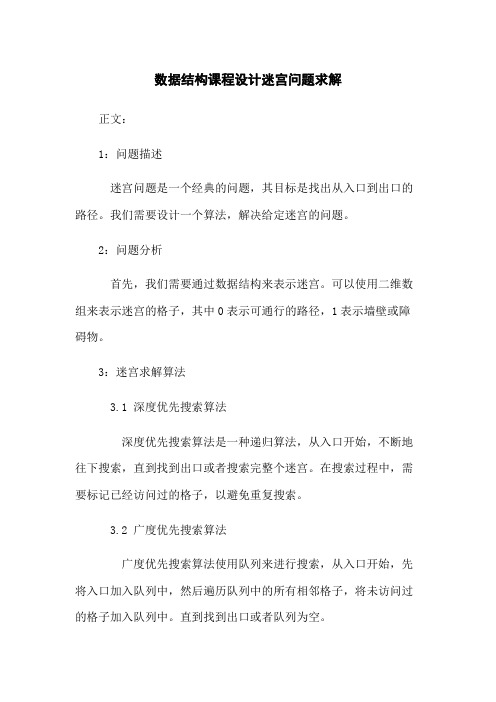
数据结构课程设计迷宫问题求解正文:1:问题描述迷宫问题是一个经典的问题,其目标是找出从入口到出口的路径。
我们需要设计一个算法,解决给定迷宫的问题。
2:问题分析首先,我们需要通过数据结构来表示迷宫。
可以使用二维数组来表示迷宫的格子,其中0表示可通行的路径,1表示墙壁或障碍物。
3:迷宫求解算法3.1 深度优先搜索算法深度优先搜索算法是一种递归算法,从入口开始,不断地往下搜索,直到找到出口或者搜索完整个迷宫。
在搜索过程中,需要标记已经访问过的格子,以避免重复搜索。
3.2 广度优先搜索算法广度优先搜索算法使用队列来进行搜索,从入口开始,先将入口加入队列中,然后遍历队列中的所有相邻格子,将未访问过的格子加入队列中。
直到找到出口或者队列为空。
3.3 最短路径算法最短路径算法可以使用Dijkstra算法或者A算法。
Dijkstra算法使用了优先队列,通过计算每个格子到入口的距离,选择最短路径。
A算法在计算格子到入口的距离时,还考虑了格子到出口的距离的估算值。
4:程序实现4.1 数据结构设计我们使用二维数组来表示迷宫的格子,使用一个额外的二维数组来标记已访问的格子。
可以使用一个结构体来表示每个格子的坐标。
4.2 算法实现我们需要实现深度优先搜索算法、广度优先搜索算法以及最短路径算法。
可以使用递归来实现深度优先搜索算法,使用队列来实现广度优先搜索算法,使用优先队列来实现最短路径算法。
4.3 界面设计可以使用命令行界面来输入迷宫的大小和格子的类型,以及展示迷宫的解法和最短路径。
5:测试与结果分析我们需要对设计的算法进行测试,并对结果进行分析。
可以创建一些不同大小和复杂度的迷宫,对算法进行测试,并统计算法的时间复杂度和空间复杂度。
6:附件本文档涉及的附件包括程序源代码和测试数据。
7:法律名词及注释7.1 数据结构:指在计算机中组织和存储数据的方式,包括数组、链表、栈、队列等。
7.2 深度优先搜索算法:一种使用递归的搜索算法,从一个节点开始,优先搜索其相邻节点,直到达到目标节点或无法继续搜索为止。
迷宫问题的求解(广度和深度优先搜索)

迷宫问题的求解(⼴度和深度优先搜索)迷宫问题主要可以分为两类,⼀个是深度优先搜索和⼴度优先搜索。
⼴度优先搜索常⽤于求最优解(如最短时间,最优路径等),站在⼀个点上,⾸先试⼀试⾃⼰周围的点是否可以⾛,如果是路则加⼊待⾛队列,如果是墙则丢弃。
迷宫问题在⼴度优先搜索的时候需要特别注意的就是要及时抛弃,遇到⾛过的点⽴即丢弃,遇到墙⽴即丢弃,不然时间复杂度就很⾼。
⼀般利⽤队列来辅助。
深度优先搜索则不需最优的特性,⽤于求解有或者没有的问题。
⼀般利⽤堆栈或递归来实现。
下⾯先介绍简单的⼆叉树的⼴度和深度优先遍历1//⼴度优先遍历2void BFS(Tree root)3 {4 queue<Node>Q;5 Q.push(root);6 Node temp;7while( Q.empty()==false){8 template = Q.front();9 Q.pop();10 printf("%d",temp->data);11if( temp->lchild){12 Q.push(temp->lchild);13 }14if( temp->rchild){15 Q.push(temp->rchild);16 }17 }1819 }1//深度优先遍历2void DFS( Tree root)3 {4 stack <Node> S;5 S.push(root);6 Node node;7while( S.empty()){8 node = S.top();9 printf("%d",node->data);10 S.pop();11if( node->rchild){12 S.push(node->rchild);13 }14if( node->lchild){15 S.push( node->lchild);16 }17 }18 }胜利⼤逃亡题⽬描述Ignatius被魔王抓⾛了,有⼀天魔王出差去了,这可是Ignatius逃亡的好机会.魔王住在⼀个城堡⾥,城堡是⼀个A*B*C的⽴⽅体,可以被表⽰成A个B*C的矩阵,刚开始Ignatius被关在(0,0,0)的位置,离开城堡的门在(A-1,B-1,C-1)的位置,现在知道魔王将在T分钟后回到城堡,Ignatius每分钟能从⼀个坐标⾛到相邻的六个坐标中的其中⼀个.现在给你城堡的地图,请你计算出Ignatius能否在魔王回来前离开城堡(只要⾛到出⼝就算离开城堡,如果⾛到出⼝的时候魔王刚好回来也算逃亡成功),如果可以请输出需要多少分钟才能离开,如果不能则输出-1.<center></center>输⼊描述:输⼊数据的第⼀⾏是⼀个正整数K,表明测试数据的数量.每组测试数据的第⼀⾏是四个正整数A,B,C和T(1<=A,B,C<=50,1<=T<=1000),它们分别代表城堡的⼤⼩和魔王回来的时间.然后是A块输⼊数据(先是第0块,然后是第1块,第2块......),每块输⼊数据有特别注意:本题的测试数据⾮常⼤,请使⽤scanf输⼊,我不能保证使⽤cin能不超时.在本OJ上请使⽤Visual C++提交.输出描述:对于每组测试数据,如果Ignatius能够在魔王回来前离开城堡,那么请输出他最少需要多少分钟,否则输出-1.⽰例1输⼊13 34 200 1 1 10 0 1 10 1 1 11 1 1 11 0 0 10 1 1 10 0 0 00 1 1 00 1 1 0输出11这道题⼀开始看题看半天,其实它就是3*3*4=36个点,是⼀个⽴体的图形,下⾯的0,1就是表⽰那个点是路还是墙1 #include<stdio.h>2 #include<queue>34using namespace std;6bool mark[50][50][50]; //标记数组7int maze[50][50][50]; //保存⽴⽅体信息89struct Node10 {11int x,y,z;12int t;13 };14 queue<Node> Q;1516int go[][3]17 {181,0,0,19 -1,0,0,200,1,0,210,-1,0,220,0,1,230,0,-124 };2526int BFS(int a,int b,int c)27 {28int i;29 Node temp;30while( Q.empty()==false)31 {32 Node now = Q.front();33 Q.pop();34for( i=0; i<6; i++)35 {36//依次扩展6个相邻结点37int nx = now.x+go[i][0];38int ny = now.y+go[i][1];39int nz = now.z+go[i][2];40if( nx<0 || nx>=a || ny<0 || ny>=b || nz<0|| nz>=c)41continue; //若再⽴⽅体外则丢弃42if( maze[nx][ny][nz]==1)43continue; //若为墙则丢弃44if( mark[nx][ny][nz]==true)45continue; //若访问过则丢弃4647 temp.x = nx;48 temp.y = ny;49 temp.z = nz;50 temp.t = now.t+1;51 Q.push(temp); //新位置加⼊队列中52 mark[nx][ny][nz] = true; //标记该位置53if( nx==a-1 && ny==b-1 && nz==c-1)54return temp.t; //到达终点55 }56 }57return -1;58 }59int main()60 {61int n;62int i,j,k;63int a,b,c,t;64int ret;65 scanf("%d",&n);66while( n--)67 {6869 scanf("%d%d%d%d",&a,&b,&c,&t);70for( i=0; i<a; i++)71 {72for( j=0; j<b; j++)73 {74for( k=0; k<c; k++)75 {76 scanf("%d",&maze[i][j][k]);77 mark[i][j][k] = false;78 }79 }80 }81while( Q.empty()==false) Q.pop(); //清空队列82 mark[0][0][0] = true; //标记起点83 Node temp;84 temp.t = temp.x = temp.y = temp.z=0;85 Q.push(temp);86 ret = BFS( a,b,c);87if( ret<=t) printf("%d\n",ret); //成功逃出输出时间,⽆法找到终点输出-188else printf("-1\n"); //若时间超过返回-189 }90return0;91 }Tempter of the bone时间限制:1秒空间限制:32768K 热度指数:148题⽬描述The doggie found a bone in an ancient maze, which fascinated him a lot. However, when he picked it up, the maze began to shake, and the doggie could feel the groundsinking. He realized that the bone was a trap, and he tried desperately to get out of this maze.The maze was a rectangle with sizes N by M. There was a door in the maze. At the beginning, the door was closed and it would open at the T-th second for a short period oftime (less than 1 second). Therefore the doggie had to arrive at the door on exactly the T-th second. In every second, he could move one block to one of the upper, lower, leftand right neighboring blocks. Once he entered a block, the ground of this block would start to sink and disappear in the next second. He could not stay at one block for morethan one second, nor could he move into a visited block. Can the poor doggie survive? Please help him.输⼊描述:The input consists of multiple test cases. The first line of each test case contains three integers N, M, and T (1 < N, M < 7; 0 < T < 50), which denote the sizes of the maze and the time at which the door will open, respectively. The next N lines 'X': a block of wall, which the doggie cannot enter;'S': the start point of the doggie;'D': the Door; or'.': an empty block.The input is terminated with three 0's. This test case is not to be processed.输出描述:For each test case, print in one line "YES" if the doggie can survive, or "NO" otherwise.⽰例1输⼊4 4 5S.X...X...XD....3 4 5S.X...X....D0 0 0输出NOYES题⽬⼤意:有⼀个n*m的迷宫,包括起点s,终点d,墙x和地⾯,0秒时主⼈公从s出发,每秒能⾛到四个与其相邻的位置中的⼀个,且每个位置被⾏⾛之后都不能再次⾛⼊,问是否存在这样⼀条路径使在T秒刚好⾛到d1 #include<stdio.h>2 #include<stdlib.h>34char maze[8][8]; //保存地图信息5int n,m,t;6int flag; //是否找到的标记7int go[][2]=8 {91,0,10 -1,0,110,1,120,-113 };1415void DFS( int x,int y, int time)16 {17int i;18int nx,ny;19for( i=0; i<4; i++)20 {21//枚举四个相邻位置2223int nx = x + go[i][0];24int ny = y + go[i][1];25if( nx<1 || nx>n || ny<1 || ny>m) continue;26if( maze[nx][ny]=='X') continue; //若该位置为墙,跳过27if( maze[nx][ny]=='D') //若该位置为门28 {29if( time+1 == t)30 {31//判断时间32 flag = 1 ;33return;34 }35else continue;36 }3738 maze[nx][ny] = 'X'; //修改该位置为墙39 DFS( nx, ny, time+1); //递归扩展该状态40 maze[nx][ny] = '.';41if( flag==1 ) return; //假如成功,直接返回42 }43 }44int main()45 {46int i,j;47int sx,sy;48while( scanf("%d%d%d",&n,&m,&t)!=EOF)49 {50if( n==0 && m==0 && t==0) break;5152for( i=1; i<=n; i++)53 {54//建构迷宫55 scanf("%s",maze[i]+1);56 }57 flag = 0; //初始化成功标记58for( i=1; i<=n; i++)59 {60for( j=1; j<=m; j++)61 {62if( maze[i][j]=='D')63 {64//寻找D位置的坐标65 sx = i;66 sy = j;67 }68 }69 }70for( i=1; i<=n; i++)71 {72for( j=1; j<=m; j++)73 {74if( maze[i][j]=='S' && (i+j)%2 ==((sx+sy)%2+t%2)%2 )75 {76//找到S点77 maze[i][j] = 'X';78 DFS(i,j,0);7980 }81 }82 }83if( flag ) printf("YES\n");84else printf("NO\n");85 }86return0;87 }这道题⼀开始剪枝不够提⽰超时,后加⼊(i+j)%2 ==((sx+sy)%2+t%2)%2这个判断的意思是每⾛⼀步,只有⼀个坐标分量发⽣增⼀或减⼀的改变,那么两个坐标分量和的奇偶性将发⽣变化。
(完整word版)迷宫问题求解最新版(新增DIY流程图)
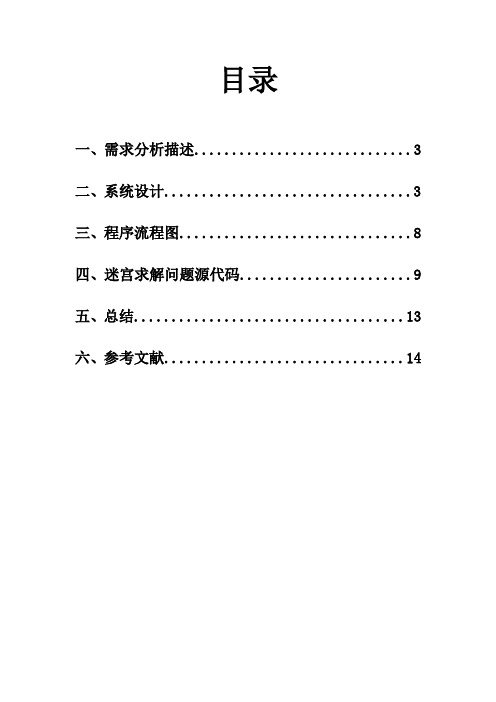
目录一、需求分析描述 (3)二、系统设计 (3)三、程序流程图 (8)四、迷宫求解问题源代码 (9)五、总结 (13)六、参考文献 (14)一需求分析1 以二维数组MazeType表示迷宫,在其周围加一圈围墙;数组中'#'表示障碍,'_'表示通路。
2 程序引导用户初始化迷宫,输入其中的障碍;3 迷宫的入口和出口可以由用户自己设定。
4 若迷宫有通路,则在其走过的路径上以'.'表示可以通过;5本程序可以求解多条路径。
既在迷宫求解过程中记下所有的走过的位置;例如:* * * * * * * * * ** _ _ # # ** _ # # ** _ _ # # ** _ # # # ** _ # # ** _ # ** _ # # # # # ** _ _ _ _ _ _ _ _ ** * * * * * * * * *二系统设计1 设定栈的抽象数据类型定义基本操作:int InitStack(SqStack &S)操作结果:构造一个空栈S;int StackEmpty(SqStack S)初始条件:栈S已存在。
操作结果:若栈为空则返回TRUE,否则返回FALSE;GETTOP(S,&e)初始条件:栈S已经存在;操作结果:若栈不为空,则以e返回栈顶元素。
int Push(SqStack &S,SElemType e)初始条件:栈已经存在。
操作结果:在栈的顶部插入新的栈顶元素;int Pop(SqStack &S,SElemType &e)初始条件:栈已经存在;操作结果:删除栈顶元素,并以E返回其值。
2 设定迷宫的抽象数据类型为:基本操作:1 void CreatMaze(int r,int l)初始条件:MazeType maze已经存在,其中从第一行到最后一行,每一行的第一个元素和最后一个元素都为'*',从第一列的到最后一列,每一列的第一个和最后一个元素的值为'*';操作结果:构成迷宫的int型数组,以'#'表示障碍,'_'表示通路。
求解迷宫问题课程设计

求解迷宫问题课程设计一、课程目标知识目标:1. 学生能理解迷宫问题的基本概念,掌握迷宫的表示方法和解决策略。
2. 学生能运用所学知识,设计并实现简单的迷宫求解算法。
3. 学生了解人工智能在解决迷宫问题中的应用。
技能目标:1. 学生能运用图论知识,绘制迷宫图,并分析其特点。
2. 学生能编写程序,实现迷宫的生成和求解。
3. 学生能通过实际操作,掌握迷宫问题的调试和优化方法。
情感态度价值观目标:1. 学生在解决迷宫问题的过程中,培养逻辑思维和问题解决能力。
2. 学生通过团队合作,培养沟通能力和团队协作精神。
3. 学生了解人工智能的发展前景,激发对计算机科学和人工智能的兴趣。
课程性质:本课程为信息技术或计算机科学相关学科的教学内容,旨在通过解决迷宫问题,提高学生的编程能力、逻辑思维和团队协作能力。
学生特点:考虑到学生所在年级,已具备一定的计算机操作和编程基础,对新鲜事物充满好奇心,但可能缺乏解决复杂问题的经验和耐心。
教学要求:教师需引导学生掌握迷宫问题的基本知识,关注学生的个体差异,提供适当的指导和支持,鼓励学生动手实践,培养其解决问题的能力。
在教学过程中,注重培养学生的团队合作精神,提高其对人工智能的兴趣。
通过本课程的学习,使学生在知识、技能和情感态度价值观方面均取得具体、可衡量的学习成果。
二、教学内容1. 迷宫问题基本概念:迷宫的表示方法、迷宫的特点及分类。
- 教材章节:第三章 图论基础,第1节 图的基本概念。
2. 迷宫问题求解策略:深度优先搜索、广度优先搜索、启发式搜索。
- 教材章节:第三章 图论基础,第3节 图的搜索算法。
3. 迷宫程序设计:C++/Python等编程语言实现迷宫的生成、求解及可视化。
- 教材章节:第五章 算法设计与分析,第1节 算法设计基础。
4. 人工智能在迷宫问题中的应用:遗传算法、神经网络等。
- 教材章节:第八章 人工智能基础,第2节 智能搜索算法。
教学大纲:第一课时:迷宫问题基本概念,介绍迷宫的表示方法和分类。
数据结构课程设计——迷宫求解问题
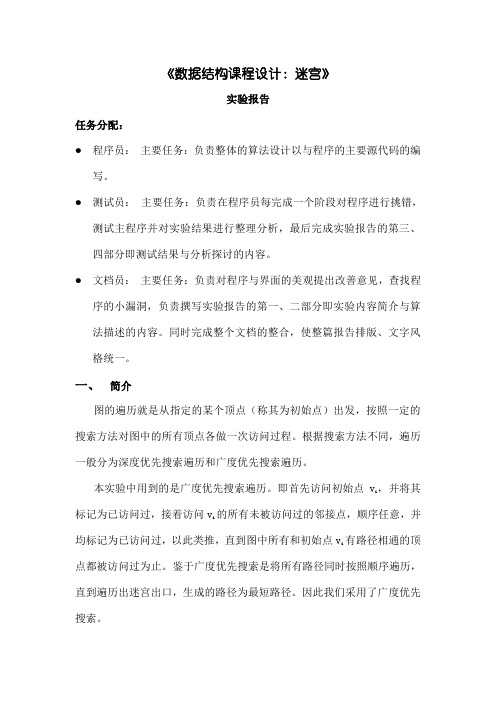
《数据结构课程设计:迷宫》实验报告任务分配:●程序员:主要任务:负责整体的算法设计以与程序的主要源代码的编写。
●测试员:主要任务:负责在程序员每完成一个阶段对程序进行挑错,测试主程序并对实验结果进行整理分析,最后完成实验报告的第三、四部分即测试结果与分析探讨的内容。
●文档员:主要任务:负责对程序与界面的美观提出改善意见,查找程序的小漏洞,负责撰写实验报告的第一、二部分即实验内容简介与算法描述的内容。
同时完成整个文档的整合,使整篇报告排版、文字风格统一。
一、简介图的遍历就是从指定的某个顶点(称其为初始点)出发,按照一定的搜索方法对图中的所有顶点各做一次访问过程。
根据搜索方法不同,遍历一般分为深度优先搜索遍历和广度优先搜索遍历。
,并将其本实验中用到的是广度优先搜索遍历。
即首先访问初始点vi的所有未被访问过的邻接点,顺序任意,并标记为已访问过,接着访问vi均标记为已访问过,以此类推,直到图中所有和初始点v有路径相通的顶i点都被访问过为止。
鉴于广度优先搜索是将所有路径同时按照顺序遍历,直到遍历出迷宫出口,生成的路径为最短路径。
因此我们采用了广度优先搜索。
无论是深度优先搜索还是广度优先搜索,其本质都是将图的二维顶点结构线性化的过程,并将当前顶点相邻的未被访问的顶点作为下一个顶点。
广度优先搜索采用队列作为数据结构。
本实验的目的是设计一个程序,实现手动或者自动生成一个n×m矩阵的迷宫,寻找一条从入口点到出口点的通路。
具体实验内容如下:选择手动或者自动生成一个n×m的迷宫,将迷宫的左上角作入口,右下角作出口,设“0”为通路,“1”为墙,即无法穿越。
假设一只老鼠从起点出发,目的为右下角终点,可向“上、下、左、右、左上、左下、右上、右下”8个方向行走。
如果迷宫可以走通,则用“■”代表“1”,用“□”代表“0”,用“☆”代表行走迷宫的路径。
输出迷宫原型图、迷宫路线图以与迷宫行走路径。
如果迷宫为死迷宫,则只输出迷宫原型图。
迷宫智力测试题目及答案
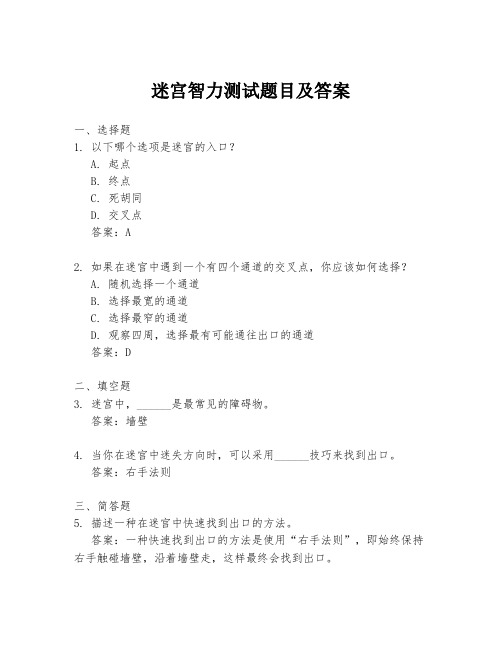
迷宫智力测试题目及答案一、选择题1. 以下哪个选项是迷宫的入口?A. 起点B. 终点C. 死胡同D. 交叉点答案:A2. 如果在迷宫中遇到一个有四个通道的交叉点,你应该如何选择?A. 随机选择一个通道B. 选择最宽的通道C. 选择最窄的通道D. 观察四周,选择最有可能通往出口的通道答案:D二、填空题3. 迷宫中,______是最常见的障碍物。
答案:墙壁4. 当你在迷宫中迷失方向时,可以采用______技巧来找到出口。
答案:右手法则三、简答题5. 描述一种在迷宫中快速找到出口的方法。
答案:一种快速找到出口的方法是使用“右手法则”,即始终保持右手触碰墙壁,沿着墙壁走,这样最终会找到出口。
四、判断题6. 在迷宫中,如果你发现自己回到了起点,那么你应该立即放弃。
答案:错误7. 迷宫中的每个通道都有可能是通往出口的路。
答案:正确五、计算题8. 如果一个迷宫有100个交叉点,每个交叉点平均有4个通道,那么迷宫中总共有多少条通道?答案:迷宫中总共有400条通道。
六、应用题9. 假设你在一个有10个房间的迷宫中,每个房间有3个门通向其他房间。
如果你从起点出发,不考虑返回,最多可以访问多少个房间?答案:最多可以访问10个房间,因为每个房间只能进入一次。
七、推理题10. 在一个复杂的迷宫中,你发现了一张纸条,上面写着:“向左走三次,然后向右走一次,你会找到宝藏。
”根据这个线索,你应该如何行动?答案:根据线索,你应该先向左走三次,然后向右走一次,按照这个顺序行动,最终找到宝藏。
- 1、下载文档前请自行甄别文档内容的完整性,平台不提供额外的编辑、内容补充、找答案等附加服务。
- 2、"仅部分预览"的文档,不可在线预览部分如存在完整性等问题,可反馈申请退款(可完整预览的文档不适用该条件!)。
- 3、如文档侵犯您的权益,请联系客服反馈,我们会尽快为您处理(人工客服工作时间:9:00-18:30)。
for (j = 0; j < width; j++) { printf("%s", ico[maze[i][j]]);//输出原始迷宫。。 } printf("\n"); } printf("Press any key to continue..\n"); getch(); /**********************搜索路径**********************/ count = 0; bestPoint = ConvertToIndex(START_X - 1, START_Y - 1);//起点设为 最佳节点。。 weight[START_X - 1][START_Y - 1] = 0;//起点权值为0。。 do { ConvertToXY(bestPoint, &x1, &y1); toBeChoosed[x1][y1] = 0; record[count] = bestPoint;//将最佳节点记录下来。。 count++; for (i = 0; i < 4; i++)//更新最佳节点周围4个点的权值大小。。 { GetDxDy(i, &dx, &dy); x = x1 + dx; y = y1 + dy; if (IsInMaze(x, y) && toBeChoosed[x][y])//如果是合法的点,而 且是待选择的点。。
课程设计任务书
学生姓名: 专业班级: 指导教师: 夏红霞 工作单位: 技术学院 题 目: 迷宫问题求解 课程设计要求: 计算机科学与
1、熟练掌握基本的数据结构; 2、熟练掌握各种算法; 3、运用高级语言编写质量高、风格好的应用程序。
课程设计任务:
1、系统应具备的功能: (1)用随机函数建立一个迷宫,给定出入口 (2)设计一个模拟走迷宫的程序寻找通路,存在则将其显示在 屏幕上 (3)找出其中途径最短的通路 2、数据结构设计; 3、主要算法设计; 4、编程及上机实现; 5、撰写课程设计报告,包括: (1)设计题目; (2)摘要和关键字; (3)正文,包括引言、需求分析、数据结构设计、算法设计、程序 实现及测试、不足之处、设计体会等; (4)结束语; (5)参考文献。
需求分析:
1、用户输入迷宫的高度和宽度。 2、根据用户输入显示生成的迷宫或者错误提示信息。 3、求出从迷宫出口到入口的最短路径。 4、显示该路径,或者无解信息。
数据结构设计:
char **maze; char ***path; char **toBeChoosed; int **weight; 录。 //迷宫,0表示障碍,非0表示可通过。 //存储每个点到入口的路径。 //待选择的结点。 //搜索到的已知的每个点到入口最短距离的记
1、 用户输入迷宫的高度和宽度。 2、 根据用户输入显示生成的迷宫或者错误提示信息。 3、 求出从迷宫出口到入口的最短路径。 4、 显示该路径,或者无解信息。
关键字:迷宫、最短路径、动态规划、Dijkstra算法 引言:
寻径问题(最短路径)是图论研究中的一个经典算法问题,旨在寻 找图(由结点和路径组成)中两结点之间的最短路径。该问题不论是在 现实(比如火星探测)还是在网络中(比如各种游戏),都具有重大意 义。
printf("Height = "); scanf("%d", &height); printf("Width = "); scanf("%d", &width); } /**********************分配相应内存空间 **********************/ maze = (char**)malloc(sizeof(char*) * height); toBeChoosed = (char**)malloc(sizeof(char*) * height); for (i = 0; i < height; i++) { maze[i] = (char*)malloc(sizeof(char) * width); toBeChoosed[i] = (char*)malloc(sizeof(char) * width); } weight = (int**)malloc(sizeof(int) * height); for (i = 0; i < height; i++) { weight[i] = (int*)malloc(sizeof(int) * width);; } path = (char***)malloc(sizeof(char**) * height); for (i = 0; i < height; i++) { path[i] = (char**)malloc(sizeof(char*) * width);; for (j = 0; j < width; j++) { path[i][j] = (char*)malloc(sizeof(char) * height * width);
int *record; int count;
//已知最佳结点的记录。 //已知最佳结点个数。
算法设计:
#include <stdio.h> #include <stdlib.h> #include <time.h> #include <conio.h> #include <string.h> #define START_X 1 #define START_Y width/2 //入口横纵坐标。。 #define END_X height #define END_Y width/2 //出口横纵坐标。。 #define MAX_W 32767 //权值上限。。 int width, height;//迷宫的宽和高。。 char ico[10][3] = {"■", "─", "│", "┌", "┐", "┘", "└", "□", "入", "出"};//各个 符号。。 int icoIndex[4][4] = { 1, 4, 0, 5, 6, 2, 5, 0, 0, 3, 1, 6, 3, 。 void GetDxDy(int i, int *dx, int *dy) { switch (i)
{ case 0://左。。 *dx = 0; *dy = 1; break; case 1://下。。 *dx = 1; *dy = 0; break; case 2://右。。 *dx = 0; *dy = -1; break; case 3://上。。 *dx = -1; *dy = 0; break; default: *dx = 0; *dy = 0; break; } } //判断该点是否是合法的,不越界。。 int IsInMaze(int x, int y) {
{ if (weight[x][y] > weight[x1][y1] + 1)//权值变小。。 { weight[x][y] = weight[x1][y1] + 1;//更新权值。。 strcpy(path[x][y], path[x1][y1]);//更新路径。。 path[x][y][strlen(path[x1][y1])] = i + 48;//添加路径。。 path[x][y][strlen(path[x1][y1]) + 1] = '\0'; } } } if (bestPoint == ConvertToIndex(END_X - 1, END_Y - 1))//如果到 出口就退出。。 { break; } bestPoint = -1; bestWeight = MAX_W; for (i = 0; i < count; i++)//在所有最佳节点的周围选择一个新的最 佳节点。。 { index = record[i]; ConvertToXY(index, &x1, &y1); for (j = 0; j < 4; j++) { GetDxDy(j, &dx, &dy); x = x1 + dx; y = y1 + dy;
path[i][j][0] = '\0'; } } record = (int*)malloc(sizeof(int) * height * width); /**********************随机生成迷宫,并显示 **********************/ srand((unsigned)time(NULL));//设置随机数种子。。 for (i = 0; i < height; i++) { for (j = 0; j < width; j++) { maze[i][j] = rand() % 3;//0表示障碍,非0表示可通过,通路:障 碍 = 2:1。。 maze[i][j] = (maze[i][j]) ? 7 : 0;//障碍物与通路的图标。。 toBeChoosed[i][j] = maze[i][j]; weight[i][j] = MAX_W; } } maze[START_X - 1][START_Y - 1] = 8;//起点图标。。 toBeChoosed[START_X - 1][START_Y - 1] = maze[START_X - 1] [START_Y - 1]; maze[END_X - 1][END_Y - 1] = 9;//终点图标。。 toBeChoosed[END_X - 1][END_Y - 1] = maze[END_X - 1][END_Y 1]; for (i = 0; i < height; i++) {
